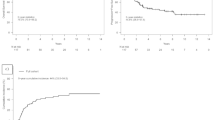Purpose:
To update the results of external radiotherapy with a focal concomitant boost technique on local control and bladder function in patients with muscle-invasive bladder cancer.
Patients and Methods:
The authors retrospectively evaluated 92 elderly or disabled patients with localized T2–4 N0–1 M0 transitional cell carcinoma of the bladder and a median age of 79 years, not suitable for radical surgery and treated between 1994 and 2005. Treatment consisted of a dose of 40 Gy/2 Gy to the small pelvis with a daily concomitant boost of 0.75 Gy to the tumor. Total dose was 55 Gy in 4 weeks.
Results:
Complete remission rate after evaluation by means of cystoscopy at 3 months was 78%. 3-year local control rate amounted to 56%, and 3-year overall survival to 36%. The posttreatment bladder capacity was comparable with the pretreatment capacity and was ≥ 200 ml in 81% of the cases. Mean bladder capacity did not deteriorate at longer follow-up.
Conclusion:
The local control rate after external beam radiotherapy in elderly patients with a focal concomitant boost for localized muscle-invasive bladder cancer was 56% at 3 years. Functional bladder outcome was good.
Ziel:
Analyse der Ergebnisse einer primären perkutanen Strahlentherapie mit konkomitanter Boost-Technik hinsichtlich lokaler Tumorkontrolle und Blasenfunktion.
Patienten und Methodik:
Retrospektive Analyse der lokalen Tumorkontrolle, des Gesamtüberlebens und der Blasenfunktion von 92 Patienten mit lokal fortgeschrittenem, nicht metastasiertem, muskelinvasivem Harnblasenkarzinom (T2–T4 N0–1 M0). Der Altersdurchschnitt betrug 79 Jahre, eine Radikaloperation war aus funktionellen Gründen nicht möglich. Die Strahlentherapie erfolgte im Zeitraum von 1994 bis 2005. Die Dosisverschreibung betrug 40 Gy/2 Gy perkutan auf das kleine Becken, zusätzlich wurde ein tumorfokussierter Boost mit täglich 0,75 Gy appliziert. Die kumulative Dosis betrug 55 Gy in 4 Wochen.
Ergebnisse:
Zystoskopisch zeigte sich bei 78% der Patienten nach 3 Monaten eine komplette Remission. Nach 3 Jahren waren noch 56% der Patienten tumorfrei. Das 3-Jahres-Überleben betrug 36%. Während der gesamten Nachbeobachtungszeit kam es zu keiner Verschlechterung der funktionellen Blasenkapazität, die bei 81% der Patienten ≥ 200 ml betrug.
Schlussfolgerung:
Die perkutane Strahlentherapie mit gleichzeitigem fokussiertem Boost führte beim muskelinvasiven Blasenkarzinom in 56% zu einer mehrjährigen lokalen Tumorkontrolle bei gleichbleibend guter Blasenfunktion.
Similar content being viewed by others
Author information
Authors and Affiliations
Corresponding author
Rights and permissions
About this article
Cite this article
Piet, A.H.M., Hulshof, M.C.C.M., Pieters, B.R. et al. Clinical Results of a Concomitant Boost Radiotherapy Technique for Muscle-Invasive Bladder Cancer. Strahlenther Onkol 184, 313–318 (2008). https://doi.org/10.1007/s00066-008-1797-3
Received:
Accepted:
Issue Date:
DOI: https://doi.org/10.1007/s00066-008-1797-3




